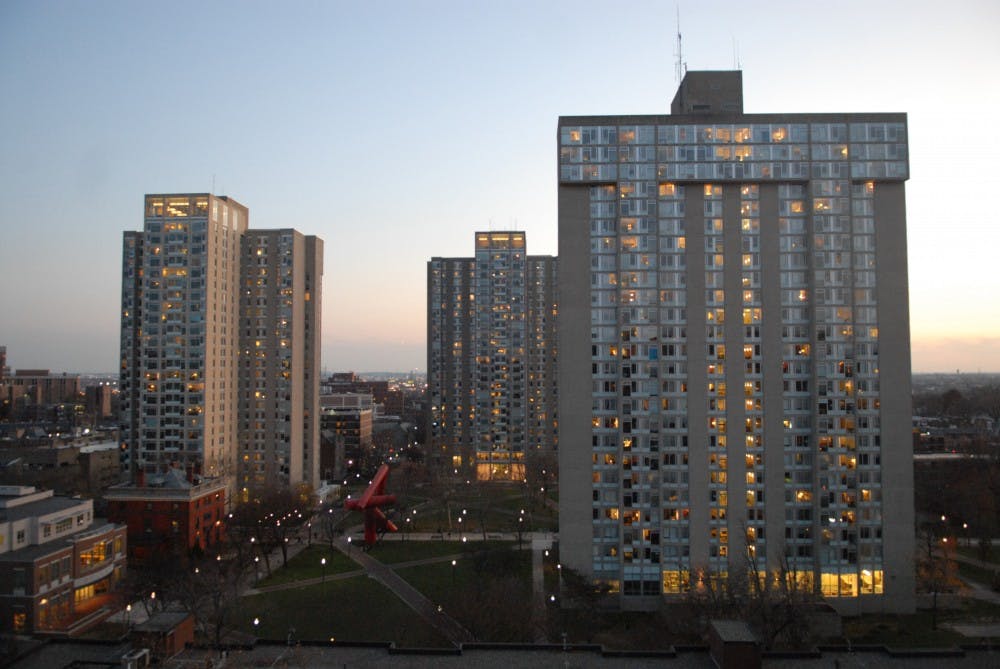
One thing all Penn students have in common is that they need a place to live. These are the stories of five different groups of students, all who went through very different channels to find their homes on campus for next year.
Venturing off-campus
For some students, on-campus housing is just not as appealing as renting a house or apartment beyond campus. Members of the Polybian Society, a political discussion group, chose to work together to find a house to rent.
Engineering junior Daniel Colson led the process.
“It was important for us to find a house because having a physical ‘home’ on-campus is really important, especially for us as a club. Without having a physical space, the organization is just an idea in everyone’s head,” Colson said.
While Colson — along with College junior Michelle Gassmann, College sophomore Robert Harrelson and six other members of the society — successfully found a house to lease, it required significantly more initiative and preparation on their part.
“The process is definitely more informal and requires a bit more tenacity,” Colson said, adding that the group had the lease for their house at 41st and Pine streets signed by early December. “I probably looked at more than 50 houses before finding this one on Craigslist.”
“It can be really tough to find good off-campus spaces, too,” Colson added, saying that they signed the lease for their house less than 24 hours after it became available.
While the process itself was tricky, it provides extra benefits for residents of the house. While a typical on-campus student will pay upwards of $900/month to live in a dorm during the academic year, members of the house will pay rent of roughly $750/month. Unlike on-campus housing, though, signing an off-campus lease generally requires a security deposit equivalent to one month’s rent.
“I like the autonomy I have living in a house — I don’t have to worry about dorm checks or signing anybody into my own house,” Gassmann said. “How ridiculous is it that you pay for a month of rent for December and January, but you’re told you aren’t allowed to come back for half of those months — no thanks.”
“As with everything in life, it’s a tradeoff. Walking the extra few blocks in the winter will suck, and a perceived danger of walking so far can be stressful, but I think it’ll be just fine,” she said.
For Harrelson, the biggest draw was living with friends. As a transfer student from University of Massachusetts, Amherst, “I didn’t know anyone well enough besides members of Polybian who didn’t have housing. When the house opened up, it solved all of my problems,” Harrelson said.
“As a transfer, I would have appreciated it if the University had been more upfront about how housing works,” Harrelson added, noting that it probably contributed to his decision to live off-campus.
Moving back on-campus
Not all students who live off-campus enjoy the experience, though. College sophomore Oscar Hernandez and Engineering sophomore Jay Havaldar currently live in Hamilton Court Apartments at 39th and Chestnut streets. After spending a year off-campus, the pair decided to move back on-campus, aiming for either the high rises or Sansom Place West.
“Off-campus costs really add up and financial aid doesn’t cover it,” Havaldar said. “You also usually have to sign a lease for an entire year, which is inconvenient if you’re not on-campus for the summer,” he added.
Though not rising sophomores, Havaldar and Hernandez applied for housing through the same inter-house selection process, but they experienced more of a challenge with their selection.
“Originally, I accidentally selected a one-bedroom double [in Sansom Place] instead of one that would give us separate bedrooms, so we applied to change our selection,” Hernandez said.
After a week, their assignment was successfully changed to a different layout.
“We actually got really lucky,” Havaldar said. “We’re in a two bedroom apartment with a living room and a kitchen in Sansom, but it doesn’t really cost any extra.”
“We’re kind of far from everyone else, but it worked out,” he said.
Residential program
Instead of leaving it up to chance, some students choose to apply to programs specifically tailored to their interests.
Michael Samuelson, Ivan Thorpe, Curtis Kuo and Loui Luna — all College freshmen — chose to apply for The Rodin Arts Collective, a residential program for students interested in visual arts, music and theater.
“We were thinking we would apply for the high rises, but then we found out that it was relatively rough odds to get in,” Samuelson said, “so we decided to apply for TRAC.”
Requiring applicants to be more proactive, applications were due the first week of the semester, which included an essay and interview.
For Samuelson, the process was worth it. “It was actually really easy. The essay was manageable and straightforward. It definitely beats what my friends who applied traditionally to the high rises went through,” he said.
With residential program applications, unlike in-house and inter-house selection, applicants don’t physically get to choose their rooms. Instead, on their application, applicants indicate which types of rooms they would be okay with, and if they are accepted, they are automatically placed into a room.
The process worked in the group’s favor. “We actually put that we wanted a three-bedroom quad on the application,” Samuelson said. “We got really lucky though and we ended up with a four-bedroom quad.”
Aside from getting an ideal room, the group has the added benefit of extra programming and common interests built in with their fellow hallmates.
“It’ll be really nice living with people who already have something in common with us,” Kuo said.
In-house selection
Engineering sophomore Aditi Vrudhula, Wharton sophomore Chelsea Awan, Wharton and College sophomore Shabnam Eghbali and College sophomore Sofia Rodriguez aimed to live in Rodin College House with a distinct advantage: three of them already lived there, which qualified them for in-house selection.
With better prospects than inter-house selection, the group set their sights high, shooting for a high-demand four-bedroom quad.
“Personally, I would have preferred to move off-campus because you get a little bit more freedom, but we already lived here and I already had roommates I liked,” Awan said.
However, unlike three-bedroom quads, which comes at one of the lowest price tags for on-campus housing, a four-bedroom quad is significantly more expensive, running more than $11,000 per academic year as compared to a three-bedroom quad’s $8,500.
“For me, price was definitely a concern. My brother is also living in a four-bedroom quad, and costs add up,” Vrudhula said.
However, Awan pointed out that it is still cheaper than paying for a single apartment in the high rises, and students still get their own bedrooms.
While demand was high for four-bedroom quads, the group was successful in their quest.
Inter-house selection
As far as housing goes, rising sophomore students tend to get the short end of the stick. Most students who choose to live on-campus go through the inter-house selection process, which comes after all other upperclassmen and residential program applicants have been placed, leaving what are generally considered the least-desirable rooms.
Wharton freshman Richard Lou, College freshman Oscar Alberto, College freshman Robert Louis and Engineering freshman Anya Hall met through intramural soccer and decided to tackle the process together. Like most other rising sophomores, the group set their sights on a three-bedroom quad in one of the high rises — the most popular type of room available during inter-house selection. More specifically, they wanted to live in Rodin.
“We knew we wanted to be in the high rises and I have [upperclassmen] friends who had already gotten housing in Rodin, so it seemed like the best option,” Lou said.
Housing entirely upperclassmen for the past two years in a row, rooms were selected in Rodin at a faster rate than either of the other two comparable high rises.
For the group, the inter-house process paid off; after getting their selection time from residential services, they chose a three-bedroom quad in Rodin.
“The high rises have all the amenities we were looking for and you don’t have to pay extra for utilities, like you would off-campus,” Lou said. “And we’re all really neat, so having our own space will be nice.”
Correction: A previous version of this article referred to College sophomore Oscar Hernandez as Oscar Murillo. The DP regrets the error.
The Daily Pennsylvanian is an independent, student-run newspaper. Please consider making a donation to support the coverage that shapes the University. Your generosity ensures a future of strong journalism at Penn.
DonatePlease note All comments are eligible for publication in The Daily Pennsylvanian.







